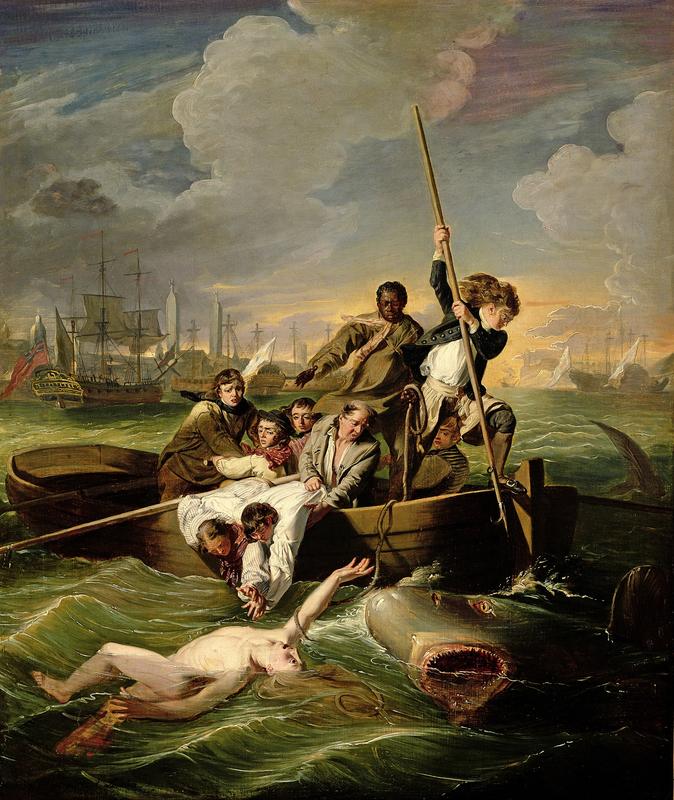More about Watson and the Shark
- All
- Info
- Shop

Sr. Contributor
Reboots have always been a fan favorite and in 1782 John Singleton Copley jumped on the bandwagon to revive one of his classics: Watson and the Shark.
The scene opens: Havana Harbor, 1749. Sailor Brook Watson was the ripe age of 14 and in desperate need of a cooling-off. Discarding his heavy woolen sailor suit, Watson dove into the warm water for a freeing skinny dip. Before the defenseless teen could realize what was happening, a great tiger shark struck his right leg and pulled him under. After the first hit, the shark had stripped the flesh from Watson’s leg, but it was still hungry. The shark attacked Watson a second time, severing his foot at the ankle. The beast was coming back for thirds, when a rescue team finally arrived. Watson was yanked aboard to safety while one fearless sailor drove a boat hook into the shark, deterring it from another attack. Watson miraculously survived the event, and was fitted with a peg leg - a life-long sign that he was a true survivor of the savage seas.
Almost thirty years later, Watson met John Singleton Copley and commissioned a monumental painting of his attack. Copley was searching for a subject to test out his history painting skills, and was happy to hear of Watson’s story of salvation. In 1778, Copley painted two copies of the scene, which are now housed at the National Gallery of Art in Washington, DC and the Boston Museum of Fine Arts. The dramatic artwork was a major hit at the Royal Academy and spearheaded Copley’s rise to fame in Europe.
Four years later, Copley returned to his easel to paint Watson and the Shark a third and final time. This version, now a cornerstone of the Detroit Institute of Arts’ collection, differs quite a bit from its predecessors. Most noticeably is the change in size and orientation. History paintings are known for their massive horizontal canvases, but in 1782 Copley challenged that notion by squeezing the elaborate event into a small, vertical frame, shrinking his original composition by over 75%.
The smaller surface area does not stop Copley from loading the work with emotion and energy; he goes all in on the gore of the attack. Blood courses down Watson’s dismembered leg that is clearly missing its foot. To reduce the horror of the event, Copley revamps Watson’s long, shiny blond hair. Watson looks more like the star of Botticelli's The Birth of Venus than a rugged young sailor in excruciating pain as his luscious locks flow out towards his attacker. As for the antagonist, we are happy to say that Copley learned a bit more about the anatomical composition of sharks since his first go. In his earlier works, Copley’s shark had forward-facing eyes, gaping nostrils that looked like a French mustache, and no gills - how was that poor creature even alive?! Probably after receiving a lot of hate for his unrealistic depiction of the world’s greatest marine predator, Copley tried a bit harder to make his 1782 shark look less like a backup dancer at a Katy Perry concert and more like the real thing. This new and improved shark has eyes on the side of his head, much smaller nostrils, and gills so he can actually breathe. Overall, the shark still looks like a giant gray sausage in the sea, but Copley gets points for trying.
In the end, we still don’t know why Copley was so motivated to paint Watson and the Shark three times, but we do know that he would be a diehard fan of Shark Week.
Sources
- O’Hearn, Megan. “Watson and the Shark: ‘a most usefull Lesson to Youth’.” Last modified July 26, 2017. https://www.artstor.org/2017/07/26/watson-and-the-shark-a-most-usefull-…
- Southgate, M. Therese. “Watson and the Shark.” Journal of American Medical Association, 291, no. 19 (2004): 2290. doi: 10.1001/jama.291.19.2290.
- “Watson and the Shark.” Detroit Institute of Arts. Accessed February 19, 2021. https://www.dia.org/art/collection/object/watson-and-shark-41300.
- “Watson and the Shark, John Singleton Copley.” National Gallery of Art. Accessed February 19, 2021. https://www.nga.gov/collection/highlights/copley-watson-and-the-shark.h….
- Zygmont, Byran. “John Singleton Copley, Watson and the Shark.” Last modified August 9, 2015. https://smarthistory.org/copley-watson-and-the-shark/.












